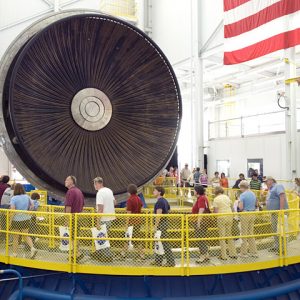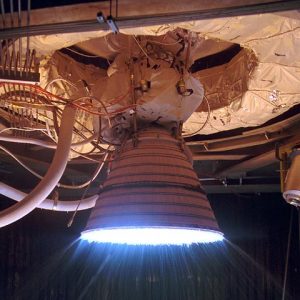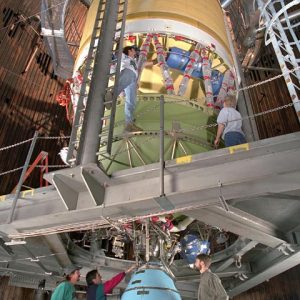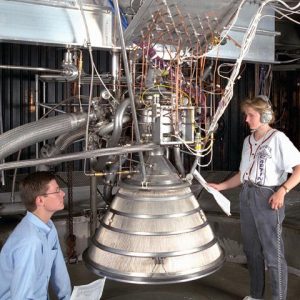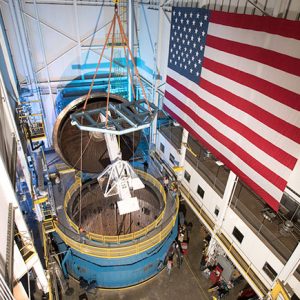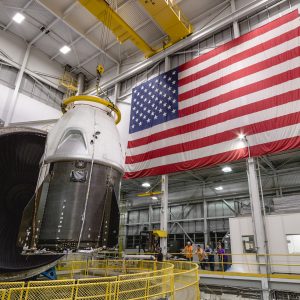In-Space Propulsion Facility
NASA’s In-Space Propulsion Facility (ISP) is the world’s only facility capable of testing full-scale upper-stage launch vehicles and rocket engines under simulated high-altitude conditions.
Facility Overview
NASA’s In-Space Propulsion Facility (ISP), formerly known as the Spacecraft Propulsion Research Facility (B–2), is the world’s only facility capable of testing full-scale upper-stage launch vehicles and rocket engines under simulated space conditions and also conducting altitude hot fire. The engine or vehicle can be exposed for indefinite periods to low ambient pressures, low-background temperatures, and dynamic solar heating, simulating the environment the hardware will encounter during orbital or interplanetary travel.
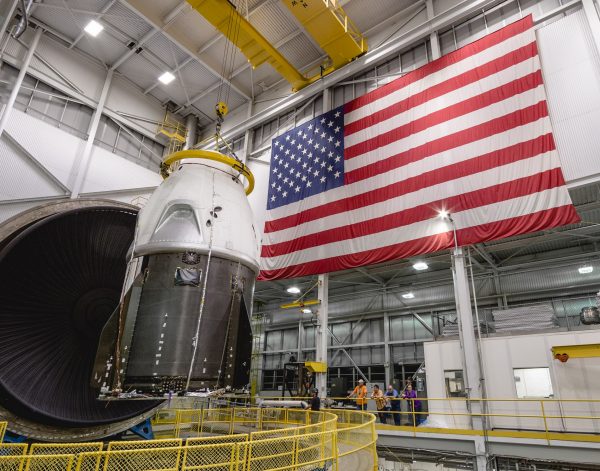
Vehicle engines producing up to 400,000-lb of thrust can be fired for either single or multiple burn missions, utilizing either cryogenic or storable fuels or oxidizers. Engine exhaust conditions can be controlled to simulate a launch ascent profile. In addition, conditions can be maintained before, during, and after the test firing. ISP offers a complete “test-as-you-fly” environment to thoroughly ground test flight hardware and reduce the likelihood of costly flight failures. In 1998, tests of the Boeing Delta III cryogenic upper stage were successfully conducted in the ISP facility.
During a typical test program, the test article is installed within the ISP vacuum chamber and the necessary electrical power, fuel, oxidizer, and purge gas connections are made. The low-pressure, temperature-controlled flight environment is established to thermally condition the hardware and propellants prior to engine firing.
A Event Sequencer conducts all aspects of the engine test firing from the start of the water deluge system until the completion of the engine test firing and facility shutdown. An abort system provides monitoring through the test period of both facility and test parameters. Test-firing periods extending up to600 sec (10 minutes) can be accommodated. Multiple test firings and thermal conditioning periods can be conducted to fully simulate the actual flight scenario.
Quick Facts
NASA’s In-Space Propulsion Facility is the world’s only high altitude test facility capable of full-scale rocket engine and launch vehicle system level tests. The facility supports mission profile thermal vacuum simulation and engine firing. The engine or vehicle can be exposed for indefinite periods to low ambient pressures, low-background temperatures, and dynamic solar heating, simulating the environment the hardware will encounter during orbital or interplanetary travel.
| Name | In-Space Propulsion Facility |
|---|---|
| Vacuum Chamber | 38 ft diameter by 62 ft tall |
| Test Volume | 33 ft diameter by 55 ft tall |
| Vacuum Range | Ambient to 5 x 10-7 Torr for space simulation, 100,000 ft for altitude propulsion testing |
| Thrust Capability | 400,000 lbf maximum, 100,000 lbf nominal |
| Facility Manager | Hal Weaver |
- The In-Space Propulsion Facility (ISP) is a one-of-a-kind facility capable of testing full-scale upper-stage launch vehicles and rocket engines under simulated high-altitude conditions.
- The In-Space Propulsion Facility has a vacuum range of up to 100 statute miles in altitude.
- ISP is one of four unique space simulation facilities located at NASA’s Neil A. Armstrong Test Facility (ATF).
Capabilities
- Capability for long duration space environment soaking of the engine module of a complete launch vehicle prior to engine start
- Capable of 10 torr engine exhaust duct pressure throughout engine firings
- Can duplicate multiple ignition sequence to simulate actual space flight operation
- Successful history of more than 100 hot firings of RL10 engines during Centaur development, 80 firings of current RL10ISP engine for Delta-3 development, and 12 firings of the Delta 3 Upper Stage
Vacuum Chamber
- 38 ft in diameter by 62 ft tall, vertical stainless steel chamber
Test Volume
- 33 ft in diameter by 55 ft tall usable test volume
Vacuum Range
- 10-7torr long duration vacuum capability (Local atmospheric pressure to 100 statute miles altitude)
Thrust Capability
- Up to 100,000 lbf of thrust nominal, 400,000 lbf of thrust maximum
Thermal Conditioning
- Vacuum chamber surfaces are lined with a liquid nitrogen cold wall, capable of maintaining -320 °F. A quartz infrared heating system can be programmed to radiate a sinusoidal distribution, simulating rotational solar heating.
Chamber Access
- 27-ft-diameter top hatch for equipment loading, two 6.5-ft personnel entry doors.
Spray Chamber
- Cooling chamber, 67 ft in diameter by 120 ft deep, located immediatelybelow the vacuum chamber containing 1.75 million gallons of chilled water.
- Deluge system cools exhaust gases at a rate of 250,000 gallons per minute with 11,000 hp pumping capacity.
Supply Systems
- Dedicated on-site storage includes:
- 33,000 gallons liquid hydrogen
- 12,000 gallons liquid oxygen
- 56,000 gallons liquid nitrogen for operation of the vacuum chamber cold wall
- Approximately 310,000 scf gaseous nitrogen, at up to 4000 psig storage pressure, with additional tube trailer stations available
- Approximately 210,000 scf gaseous helium, including 70,000 scf at up to 5000 psig storage pressure, with additional tube trailer stations available
- Capability to accommodate liquid methane operations
Altitude Exhaust Systems
- Two, three-stage steam-operated ejector systems provide hot fire altitude simulation up to 100,000 feet altitude.
- The system can also simulate launch ascent pressure profile.
- Exhaust system can accommodate a variety of upper stage propellant combinations including, but not limited to, liquid hydrogen, liquid oxygen, liquid methane, hydrogen peroxide, and RP-1.
Test Control
- Control room located 2600 ft from the test site.
Contact
In-Space Propulsion Facility
Facility Manager: Hal Weaver
419-621-2219
Harold.F.Weaver@nasa.gov
Neil A. Armstrong Test Facility (ATF)
Deputy Director: David Taylor
419-621-2101
David.E.Taylor@nasa.gov
Using Our Facilities
NASA’s Glenn Research Center provides ground test facilities to industry, government, and academia. If you are considering testing in one of our facilities or would like further information about a specific facility or capability, please let us know.
Did you test in one of our facilities? Let us know about your experience by participating in our customer facility evaluation survey.

